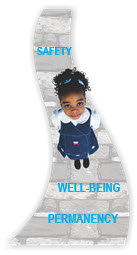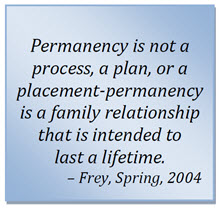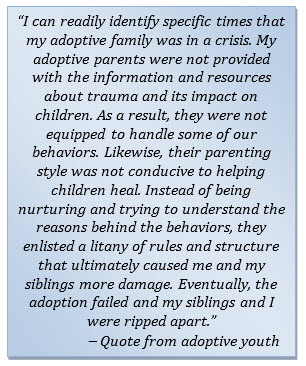-
Permanency Support and Preservation Model
-
Overview
 Overview
Overview
In 1992, The National Resource Center for Adoption (NRCA) published “Building a Model Adoption Program,” detailing components to help child welfare systems build an effective adoption program. The Model focused on three fundamental concepts:A comprehensive continuum of community-based services for all adoption parties is essential to build an effective model program.
>Adoption is a life-long process, and adoptive families should feel comfortable accessing services when development or adoption issues emerge that cause them stress.
Involvement of communities, agencies, and individuals in key adoption decisions improves adoption programs and practices.Twenty-two years later these concepts still hold true. The past decade has seen drastic changes in the adoption arena with movement away from “closed” adoptions and a general recognition that inclusion of birth families benefits all parties. Child welfare systems nationwide acknowledge that adoption is a life-long process and realize their responsibility to ensure services and supports are in place for families post permanency. Many relatives want to become permanent resources for their kin, resulting in changes in practice and an increase in the number of children who obtain permanency with their kin. Expanding knowledge about trauma and its short- and long-term impact on abused and neglected children has resulted in changes to foster/adoptive parents’ role in helping children “heal” and advances in the training, preparation and services that systems provide.
 Despite these changes, there is still a need for child welfare agencies to enhance their systems to include comprehensive continuums of care that prepare, support and encourage permanency from entry to exit. NRCA has developed a Permanency Support and Preservation Model that provides a framework for practice related to permanency services and embodies a solution-focused approach concentrating on prevention. The Model’s components are designed to bolster permanency and decrease disruption and dissolution of adoptions and guardianships.
Despite these changes, there is still a need for child welfare agencies to enhance their systems to include comprehensive continuums of care that prepare, support and encourage permanency from entry to exit. NRCA has developed a Permanency Support and Preservation Model that provides a framework for practice related to permanency services and embodies a solution-focused approach concentrating on prevention. The Model’s components are designed to bolster permanency and decrease disruption and dissolution of adoptions and guardianships. -
Components of the Model
The Model provides a framework for practice related to permanency services and embodies a solution-focused approach concentrating on prevention. The Model’s components are designed to bolster permanency and decrease disruption and dissolution of adoptions and guardianship. The model consist of the following three components:
- Guiding principles: The philosophical orientation and organizational values for the Model. The principles are the foundation from which the Model is built.
- Framework for Developing a Continuum of Sustainable Permanency-Focused Services: An approach for developing a system focused on permanency that integrates individual, organizational and community-based inputs. The framework provides the structure and pillars for the Model.
- Path to Positive Adoption/Guardianship Outcomes: Tip sheets that provide practical information on some of the fundamental components that need to be embedded in child welfare systems to successfully achieve outcomes.
-
Why should states consider a new model?
 Public child welfare agencies have a level of responsibility for children post permanency. The Information Memorandum issued by Administration for Children and Families on 5/30/14 states, “We (ACF) encourage states to develop and provide a continuum of post-adoption services for adoptive families, both domestic and international.” This responsibility is heightened by the sheer number of children on the post-permanency side versus those in care. States need to develop meaningful and long-term strategies that result in effective permanency support and preservation services. Nationwide, states are seeking ways to refine their permanency support and preservation services to ensure that children are kept safe and are growing up in permanent homes that enhance their well-being. With limited resources and compounding stressors, child welfare systems must identify effective ways to alter practice and programs that promote permanency outcomes. The NRCA Model provides states with a framework that enhances their ability to identify needs and trends, coordinate community efforts, leverage existing resources, and create a continuum of care, including a coherent, coordinated set of services that are planned, managed and delivered to adoptive/guardianship families before, during and after finalization. A range of organizations will provide these services, and a multitude of cross-disciplinary professionals and informal caregivers will perform them. The Model serves as a guide for implementing a prevention- and solution-focused approach to post permanency. States can use it to assess their own systems and to identify opportunities for refinement and innovation so they provide a robust continuum of permanency support and preservation services.
Public child welfare agencies have a level of responsibility for children post permanency. The Information Memorandum issued by Administration for Children and Families on 5/30/14 states, “We (ACF) encourage states to develop and provide a continuum of post-adoption services for adoptive families, both domestic and international.” This responsibility is heightened by the sheer number of children on the post-permanency side versus those in care. States need to develop meaningful and long-term strategies that result in effective permanency support and preservation services. Nationwide, states are seeking ways to refine their permanency support and preservation services to ensure that children are kept safe and are growing up in permanent homes that enhance their well-being. With limited resources and compounding stressors, child welfare systems must identify effective ways to alter practice and programs that promote permanency outcomes. The NRCA Model provides states with a framework that enhances their ability to identify needs and trends, coordinate community efforts, leverage existing resources, and create a continuum of care, including a coherent, coordinated set of services that are planned, managed and delivered to adoptive/guardianship families before, during and after finalization. A range of organizations will provide these services, and a multitude of cross-disciplinary professionals and informal caregivers will perform them. The Model serves as a guide for implementing a prevention- and solution-focused approach to post permanency. States can use it to assess their own systems and to identify opportunities for refinement and innovation so they provide a robust continuum of permanency support and preservation services.
-
-
Readiness Assessment Tool for a Community-Based System of Care
Lead Author: Gregory Kurth As a 20-year experienced social services professional, Gregory Kurth, consults with social services organizations on cross sector partnerships, capacity building, and social innovation. He launched Florida’s first community-based, post-adoption program in 2006 as the former CEO of a large child welfare lead agency.Introduction
 Collaboration is certainly not new to child welfare systems and communities providing post-permanency services. Since the enactment of the Adoptions and Safe Families Act (ASFA) of 1997, public and private leaders have been creating partnerships around post-permanency activities, developing meaningful collaborations, and coordinating professional service arrays to support the record number of children in adoption and guardianship arrangements. Continuums of care are being built with a number of resource and referral coordination systems, newly specialized permanency competencies for professionals, educational and support services to parents and youth, and enhanced and intensive therapeutic approaches. While a number of state, regional, and county child welfare systems are building continuums of ongoing adoption support, there has not been a consistent pathway that best assesses a community’s readiness or assets for developing a robust ecosystem of post-permanency activities. Much has been written about best practices needs for post permanency supports and services, but little has been developed about how to build a comprehensive, evolving, and cohesive community-based, post-permanency system. The National Resource Center for Adoption (NRCA) Readiness Assessment Tool provides a framework for public child welfare systems to build an ecosystem of post-permanency services. The significant increase of children in finalized adoptive placements as well as guardianships necessitates a multi-system approach of utilizing government, professional, and community assets. The tool provides an outline for a framework that ensures organizational and parent engagement components are leveraged collectively to allow for enhanced and sustained service arrays and supports for adoptive families. The tool should be supported by an action plan with meaningful discussion and dialogue that ultimately helps communities customize their own solutions. States, Tribes and Territories (STTs) can utilize the tool to assess their community-based system of care and identify components that they can add/reframe to further enhance their existing service array. This tool was developed with insight and background from interviews held in November 2013 with public and private adoptions leaders from the following 11 states: Alabama, Connecticut, Florida, Iowa, North Dakota, Oregon, Pennsylvania, South Dakota, Tennessee, Utah, and Vermont. The tool includes two components:
Collaboration is certainly not new to child welfare systems and communities providing post-permanency services. Since the enactment of the Adoptions and Safe Families Act (ASFA) of 1997, public and private leaders have been creating partnerships around post-permanency activities, developing meaningful collaborations, and coordinating professional service arrays to support the record number of children in adoption and guardianship arrangements. Continuums of care are being built with a number of resource and referral coordination systems, newly specialized permanency competencies for professionals, educational and support services to parents and youth, and enhanced and intensive therapeutic approaches. While a number of state, regional, and county child welfare systems are building continuums of ongoing adoption support, there has not been a consistent pathway that best assesses a community’s readiness or assets for developing a robust ecosystem of post-permanency activities. Much has been written about best practices needs for post permanency supports and services, but little has been developed about how to build a comprehensive, evolving, and cohesive community-based, post-permanency system. The National Resource Center for Adoption (NRCA) Readiness Assessment Tool provides a framework for public child welfare systems to build an ecosystem of post-permanency services. The significant increase of children in finalized adoptive placements as well as guardianships necessitates a multi-system approach of utilizing government, professional, and community assets. The tool provides an outline for a framework that ensures organizational and parent engagement components are leveraged collectively to allow for enhanced and sustained service arrays and supports for adoptive families. The tool should be supported by an action plan with meaningful discussion and dialogue that ultimately helps communities customize their own solutions. States, Tribes and Territories (STTs) can utilize the tool to assess their community-based system of care and identify components that they can add/reframe to further enhance their existing service array. This tool was developed with insight and background from interviews held in November 2013 with public and private adoptions leaders from the following 11 states: Alabama, Connecticut, Florida, Iowa, North Dakota, Oregon, Pennsylvania, South Dakota, Tennessee, Utah, and Vermont. The tool includes two components:
- An assessment that highlights components needed for the development of an adaptive and coordinated system of resources, communication, civic engagement and advocacy for a meaningful preservation program. STTs can complete the assessment to determine where they can enhance their system of care through increased community engagement/partnership.
- A document that provides an overview of the need for a systems approach in providing post- permanency services as well as more in-depth information on the components that are highlighted in the assessment. The document is broken into sections based on the components described in the assessment. STTs can refer to this document to obtain examples or additional information that will help them to implement that particular component within their system of care.
Click here to view the Readiness Assessment Tool or view the information as a PDF here.
Models/Tools
Home1 / Professionals2 / Academy3 / NRCA: National Resource Center for Adoption Archive4 / Models/Tools
Helpful Links
About
Contact
Guide to Becoming a Foster Parent
Guide to Adoption
Donate
Contact Us
16250 Northland Drive, Suite 120
Southfield, MI 48075
Phone: 248 443 0300
Fax: 248 443 7099

